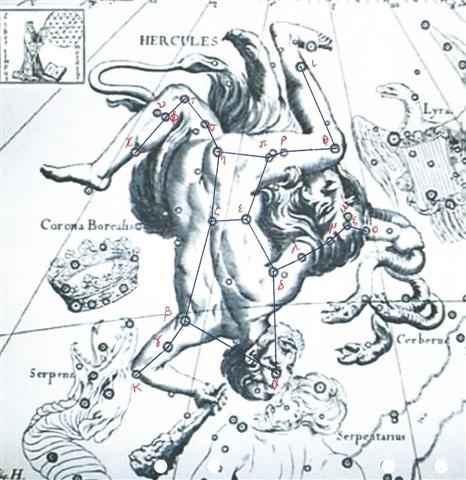71. From Te Pou,
marked by Regulus and Sadalmelik (i.e. by the line from
10h to 22h), the Explorers went on, following in the
path of the dream soul of Hau Maka at the time when he had
been sleeping in Hiva.
At the time of
Hyadum II the little lion (Regulus) would have been
at the Sun in JUNE 17. And from there to heliacal Sirius
there should have been 181 (JUNE 30) - 168 (JUNE 17) =
13 (= 260 / 20) days. Which means the corresponding time frame
could have been
that of the Goat:
|
time of the Goat |
 |
 |
 |
 |
 |
|
Ca3-21 |
Ca3-22 (73) |
Ca3-23 |
Ca3-24 |
Ca3-25 |
|
tagata tuu rima ki ruga |
te maitaki |
te henua |
Rei hata ia |
tagata rogo |
|
MARCH 29
(88, 3-29) |
HASSALEH (*73) |
HAEDUS I |
HAEDUS II |
CURSA |
|
June 1 (152) |
2 |
3 |
4 |
5 |
|
°May 28 (148) |
29 |
30 |
31 |
°June 1 (152) |
|
'May 5 (125) |
6 |
7 |
8 |
9 |
|
"April 21 (111) |
22 |
23 |
24 |
Vaitu Nui 25 |
|
JUNE
13 |
14
(*85) |
15 |
16 |
(168 = 181 -
13) |
|
18 |
19 |
 |
 |
 |
 |
 |
 |
 |
|
Ga4-1 (84) |
Ga4-2 |
Ga4-3 |
Ga4-4 |
Ga4-5 |
Ga4-6 |
Ga4-7 |
|
υ¹
Hydrae (148.4),
RAS
ELASET
BOREALIS = μ Leonis
(148.7) |
TSEEN KE (Heaven's Record) = φ Velorum
(149.9) |
ν
Leonis (150.1), π Leonis (150.6) |
υ²
Hydrae (151.8) |
Al
Jabhah-8 /
Maghā-10 /
Sharru-14
(King)
10h
(152.2)
AL JABHAH = η Leonis
(152.4),
REGULUS
= α Leonis
(152.7) |
λ
Hydrae
(153.2) |
ADHAFERA = ζ Leonis, TANIA BOREALIS = λ Ursae
Majoris, SIMIRAM = ω Carinae
(154.7) |
|
August 16 |
17
(229) |
18 |
19 |
20
(*152) |
21
(*77 + *76) |
22 |
|
°August 12 |
13
(225) |
14 |
15 |
16
(*148) |
17 |
18 |
|
'July 20 (201) |
21 |
22 /
7 |
23 |
24
(*125) |
25 |
26 |
|
"July 6 (*107) |
7 |
8 |
9 |
Anakena 10
(Te Pou) |
11 (192)
Te Pou |
12
Hua Reva |
|
Hanga
Takaure |
|
NAKSHATRA DATES: |
|
LUCIA |
14
(*268) |
DECEMBER 15 |
16
(350) |
17 |
|
18 |
19 |
|
KUH
(Weeping)
= μ
Capricorni
(331.4), γ Gruis (331.5) |
no star listed (332) |
η Piscis Austrini
(333.4) |
22h
(334.8)
KAE
UH (Roof) = ο Aquarii
(334.0),
AL
KURHAH = ξ Cephei
(334.4),
SADALMELIK
= α
Aquarii,
AL DHANAB = λ Gruis
(334.6), ι Aquarii,
ν Pegasi (334.7) |
ι Pegasi (335.0),
ALNAIR = α Gruis
(335.1), μ Piscis
Austrini, υ Piscis Austrini (335.3),
WOO
(Pestle) = π Pegasi
(335.7),
BAHAM = θ Pegasi,
τ Piscis Austrini (335.8) |
ζ
Cephei
(336.2),
λ Cephei
(336.3), -/270 Lac. (336.7),
λ
Piscis Austrini
(336.8) |
μ Gruis (337.0),
ε
Cephei
(337.2), 1/325 Lac. (337.3),
ANCHA = θ Aquarii
(337.4), ψ Oct. (337.5), α Tucanae (337.9) |
|
February 15 |
16 |
17
(14 * 29½) |
18 (414) |
19 |
20 |
21
(52) |
|
°February 11 |
12 |
13 |
2-14 |
15 |
16
(*332) |
17
(413) |
|
'January 19 (384) |
20 |
21 |
22 |
23
(*308) |
24 |
25 |
|
"January 5 |
6 |
7
(372) |
8 |
9 |
10
(*295) |
11 |
|
They took their
provisions with them, carrying them on their
shoulders, went on, and reached Te Pou.
They made camp and slept in Te Pou on the
tenth day of the month of July ('Anakena'). |
|
 
...
When the Pope rearranged the day for spring
equinox from number 84 ('March 25) to number 80
(ºMarch 21) the earlier Julian structure was
buried, was covered up (puo). At the same
time the Pope deliberately avoided to correct
the flow of Julian calendar days for what he may
have regarded as 4 unneccesary leap days prior
to the Council of Nicaea. Thus his balance sheet
for days was in order. The day numbers counted
from the equinox were increased with 4 and this
was equal to allowing the 4 'unneccessary' leap
days to remain in place. But he had moved spring
equinox to a position which was 4 days too early
compared to the ancient model
...
These '4 unneccessary leap days' (prior to the
Council of Nicaea) were equal in number to the
precessional distance in time between the Pope
and the time of rongorongo. The Gregorian
calendar could therefore be easily understood by
the Easter Islanders. The Pope had created a
'crooked calendar' but since his time the
precession had fixed it
...
The correct days
for 10h and 22h should have been at heliacal
Regulus respectively at heliacal Sadalmelik. |
|
Then they all got
up, carried their provisions on their shoulders,
went straight ahead, and followed the path of
the dream soul of Hau Maka. They came to
Hua Reva and said, This is Hua Reva A
Hau Maka!
They went on and
reached Akahanga, took a look at it and
looked around. They said: This is it! and gave
the name Akahanga A Hau Maka.
They went on and
came to Hatinga Te Kohe and saw that in
this place the kohe plant had been
broken. They all said, Here it is, the kohe
plant, troop of young men! This kohe plant had
been broken by the feet of the dream soul and
therefore they gave the name Hatinga Te Kohe
A Hau Maka.
They went on and
came to Roto Iri Are. Again they said,
There it is, Roto Iri Are and named (the
place) Roto Iri Are A Hau Maka.
They went on and
reached Tama. They looked around and
said, This is Tama. They gave the name
Tama, an evil fish (he ika kino), a
very long nose (He ihu roroa).
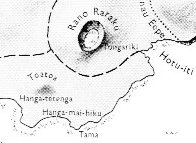
Again they went
on and came to One Tea. They saw it,
looked around, and gave the name One Tea A
Hau Maka.
Then they went on
and came to Hanga Takaure. There they
gave the name Hanga Takaure A Hau Maka.
They made camp and rested at the Bay of Flies
for a week (etahi pohitu). |
The Explorers went on from place to place
and it may have meant we should understand they spent around one day (glyph) for each place, amounting
to a total of 7 and equal to the week when they had their
camp at Hanga Takaure.
|
JUNE
20 (*91) |
SOLSTICE |
22 |
23
(174) |
 |
 |
 |
 |
|
Ga4-8 |
Ga4-9 (92) |
Ga4-10 |
Ga4-11 |
|
ALGIEBA = γ Leonis, q Carinae
(155.5) |
TANIA AUSTRALIS = μ Ursae Majoris
(156.0),
GHOST OF JUPITER
= NGC3242 Hydrae
(156.8) |
Extended Net-26b
μ
Hydrae
(157.1) |
Maru-sha-arkat-Sharru-15
(4th Son behind the
King)
SHIR
= ρ Leonis
(158.9) |
|
August 23 |
24
(4 * 59 = 236) |
25 (*157) |
26 |
|
°August 19 |
20
(232) |
21
(*153) |
22 |
|
'July 27 (*128) |
28 |
29
(210) |
30 |
|
"July 13 (*114)
Akahanga |
14
Hatinga Te Kohe |
15
(196) Roto Iri Are |
16 Tama |
|
Hanga
Takaure |
|
NAKSHATRA DATES: |
|
DECEMBER 20 (354) |
SOLSTICE |
22 |
23
(*277) |
|
Al
Sa'ad al Ahbiyah-23 /
Shatabisha-25
ε Oct. (338.1), ρ
Aquarii (338.2), 2/365 Lac. (338.5),
SADACHBIA = γ Aquarii
(338.6), π Gruis (338.9) |
β/172 Lac. (339.2),
4/1100 Lac. (339.4),
π
Aquarii
(339.5) |
δ Tucanae (340.1), ρ
Cephei (340.2), ν Gruis (340.3),
ζ Aquarii, δ
Gruis (340.4), 5/1100 Lac. (340.7), σ Aquarii,
6/650 Lac. (340.9) |
υ Oct. (341.0), α/91
Lac. (341.1),
HOMAN = ζ Pegasi,
β Piscis Austrini (341.2), ν Tucanae (341.5), υ
Aquarii (341.9) |
|
February 22 (53) |
TERMINALIA |
24
(*340) |
25 |
|
°February 18 |
19
(50) |
20
(*336) |
21 |
|
'January 26 |
27
(392) |
28 |
29
(*314) |
|
"January 12 |
13
(378) |
14 |
15
(*300) |
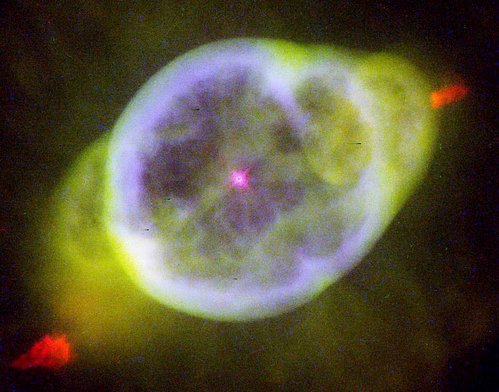
|
Tama
1. Shoot (of plant), tama
miro, tree shoot; tama tôa, shoot of
sugarcane. 2. Poles, sticks, rods of a frame. 3.
Sun rays. 4. Group of people travelling in
formation. 5. To listen attentively (with ear,
tariga, as subject, e.g. he tama te
tariga); e-tama rivariva tokorua tariga
ki taaku kî, listen carefully to my words.
Tamahahine, female. Tamahine (=
tamahahine), female, when speaking of
chickens: moa tamahine, hen. Tamâroa,
male. Vanaga.
1. Child. P Pau.: tama riki,
child. Mgv.: tama, son, daughter, applied
at any age. Mq.: tama, son, child, young
of animals. Ta.: tama, child.
Tamaahine (tama 1 - ahine),
daughter, female. Tamaiti, child P Mq.:
temeiti, temeii, young person.
Ta.: tamaiti, child. Tamaroa, boy,
male. P Mgv.: tamaroa, boy, man, male.
Mq.: tamaóa, boy. Ta.: tamaroa,
id. 2. To align. Churchill.
In the Polynesian this [tama
na, father in the Efaté language] is
distinguished from táma child by the
accent tamā
or by the addition of a final syllable which
automatically secures the same incidence of the
accent, tamái,
tamana
... Churchill 2 |
|
ST
JOHN'S DAY |
|
JUNE 25 |
26
(177) |
27 |
 |
 |
 |
 |
|
Ga4-12 (95) |
Ga4-13 |
Ga4-14 |
Ga4-15 |
|
p
Carinae
(159.3) |
φ
Hydrae
(160.3) |
no
star listed (161) |
VATHORZ POSTERIOR = θ Carinae
(162.1),
PEREGRINI = μ Velorum,
η Carinae (162.6) |
|
August 27 |
28
(240) |
29
(*161) |
30 |
|
°August 23 |
24
(236) |
25 (*157) |
26 |
|
'July 31 |
'August 1 |
2
(214) |
3
(*500) |
|
"July 17
One Tea |
Anakena 18
Poike |
19
(200) Pua Katiki |
20
(*121)
Maunga Teatea |
|
Hanga Takaure |
Hanga Hoonu |
|
NAKSHATRA DATES: |
|
CHRISTMAS EVE |
|
DECEMBER 25 |
26
(360) |
27 |
|
η
Aquarii
(342.1), σ Gruis (340.4),
SITULA = κ Aquarii
(342.7) |
ε Piscis Austrini
(343.5), ο Pegasi, β Gruis (343.8) |
ρ Gruis (344.0),
MATAR
(Rain) = η Pegasi
(344.2), η Gruis (344.6), β Oct. (344.7) |
λ Pegasi (345.0), ξ
Pegasi (345.1), ε Gruis (345.3), τ Aquarii
(345.7), ξ Oct. (345.8), μ Pegasi (345.9) |
|
February 26 |
27
(58) |
28
(424) |
March 1 (*345) |
|
°February 22 |
TERMINALIA |
24
(55) |
25 |
|
'January 30 (*315) |
31 |
'February 1 (32) |
2 |
|
"January 16 (*301) |
17 |
18 (383) |
19 |
|
On the eighteenth
day of the month of July ('Anakena') they
went on from Hanga Takaure. |
Similarly we could then count 5 days (kuhane
stations) from
Anakena 18 to Anakena 23 - corresponding to
the time the Explorers spent at Hanga Hoonu:
|
JUNE 28 |
29 (180) |
|
SIRIUS |
JULY 1 (*102) |
 |
 |
 |
 |
|
Ga4-16 |
Ga4-17 (100 = 180 - 80) |
Ga4-18 (101) |
Ga4-19 |
|
ν Hydrae (163.1) |
no star listed (164) |
Wings-27
η Oct. (165.4),
ALKES = α Crateris
(165.6) |
ANA-TIPU-4
(Upper-side-pillar - where the guards stood)
MERAK = β Ursae Majoris
(166.2),
DUBHE = α Ursae Majoris
(166.7) |
|
August 31 |
September 1 |
2 (*165) |
3 (246) |
|
°August 27 |
28 |
29 (*161) |
30 (242) |
|
'August 4 (216) |
5 (*137) |
6 |
7 |
|
"July 21
Mahatua |
22 / 7
Taharoa |
Anakena
23 (204)
Rangi Meamea |
24 (*125) |
|
Hanga Hoonu |
|
NAKSHATRA DATES: |
|
DECEMBER 28 |
29 |
|
30 (364) |
31 (*285) |
|
ι Cephei
(346.0), λ Aquarii, γ Piscis Austrini, σ
Pegasi (346.5) |
SCHEAT AQUARII = δ Aquarii
(347.0), ρ Pegasi (347.2), δ Piscis Austrini
(347.4),
FOMALHAUT = α Piscis Austrini,
τ Gruis (347.8) |
FUM AL SAMAKAH = β Piscium
(348.3), ζ Gruis (348.5),
ο
Andromedae
(348.9) |
Al Fargh al Mukdim-24 /
Purva Bhādrapadā-26 /
House-13
SCHEAT PEGASI = β Pegasi,
π Piscis Austrini (349.3), κ Gruis (349.4),
MARKAB PEGASI = α Pegasi
(349.5) |
|
March 2 |
3 |
4 (*348) |
5 (64) |
|
°February 26 |
27 |
28 (*344) |
°March 1 (60) |
|
'February 3 |
4 |
5 (*321) |
6 (37) |
|
"January 20 |
21 (2 * 193
= 386) |
22 |
23 |
|
They climbed
uphill, went on, and reached Poike.
When they arrived, they looked around and
named (the place) Poike A Hau Maka.
They climbed
up farther to Pua Katiki. When they
arrived there, they looked around and named
(the place) Pua Katiki A Hau Maka.
They came
down from the height, from the mountain,
from Pua Katiki, and reached
Maunga Teatea. They looked around and
gave the name Maunga Teatea A Hau Maka.
They all
descended, they all came down from Pua
Katiki. They reached Mahatua, saw
it, looked around, and gave the name
Mahatua A Hau Maka.
Then they
went on and came to Taharoa. They saw
it, looked around, and gave the name
Taharoa A Hau Maka.
Again they
went on and reached Hanga Hoonu. They
saw it, looked around, and gave the name
Hanga Hoonu A Hau Maka ... They remained
in Hanga Hoonu for five days.
On the
twenty-third day of the month of July ('Anakena'),
they reached Rangi Meamea.
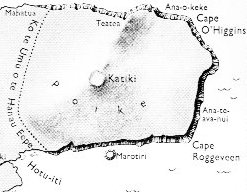
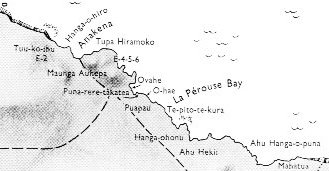 |
|



